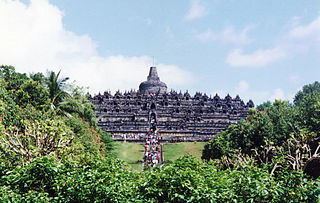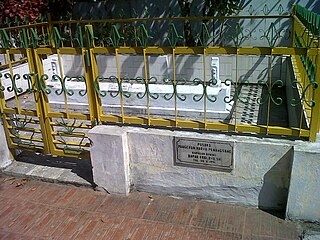
The Sultanate of Mataram was the last major independent Javanese kingdom on the island of Java before it was colonised by the Dutch. It was the dominant political force radiating from the interior of Central Java from the late 16th century until the beginning of the 18th century.

The Kingdom of Pajang or Sultanate of Pajang was a short-lived Muslim state in Java. It was established by Hadiwijaya or Jaka Tingkir, Lord of Boyolali, after a civil war and was a successor to Sultanate of Demak. Hadiwijaya claimed to be a descendant of Brawijaya V, the last king of the Majapahit empire, and Trenggana, the sultan of Demak.

The Wali Songo are revered saints of Islam in Indonesia, especially on the island of Java, because of their historic role in the spread of Islam in Indonesia. The word wali is Arabic for "trusted one" or "friend of God", while the word sanga is Javanese for the number nine.
Sunan Kudus, founder of Kudus, is considered to be one of the Wali Sanga of Java, Indonesia.

Portuguese control of Malacca –a city on the Malay Peninsula– spanned a 130 year period from 1511 to 1641 as a possession of the Portuguese East Indies. It was captured from the Malacca Sultanate as part of Portuguese attempts to gain control of trade in the region. Although multiple attempts to conquer it were repulsed, the city was eventually lost to an alliance of Dutch and regional forces, thus beginning a period of Dutch rule.

The Demak Sultanate was a Javanese Muslim state located on Java's north coast in Indonesia, at the site of the present-day city of Demak. A port fief to the Hindu-Buddhist Majapahit kingdom thought to have been founded in the last quarter of the 15th century, it was influenced by Islam brought by Muslim traders from China, Gujarat, Arabia and also Islamic kingdoms in the region, such as Samudra Pasai, Malacca and Bani (Muslim) Champa. The sultanate was the first Muslim state in Java, and once dominated most of the northern coast of Java and southern Sumatra.

Jepara is a regency in the northeast of the Indonesian province of Central Java. It covers an area of 1,020.25 km2 and had a population of 1,097,280 at the 2010 census and 1,184,947 at the 2020 census; the official estimate as at mid 2023 was 1,264,598. Its capital is Jepara town.
Sunan Ampel was one of the Javanese nine revered saints Wali Songo, credited for the spread of Islam in Java. According to local history around Demak the mosque of Demak Masjid Agung Demak was built by Sunan Ampel in 1479 CE, but other sources credited the construction of the mosque to Sunan Kalijaga.
Sultan Hadlirin or also known as Toyib of Kalinyamat, is the duke of Kalinyamat, a vassal of Demak Sultanate. He was dubbed as Sultan Hadlirin because he came to Jepara to propagate Islam in Java. Sultan Hadlirin's wife is the princess of Demak, the daughter of Demak Sultan Trenggana, Ratna Kencana, which popularly known as Ratu Kalinyamat.

Ratu Kalinyamat or Ratna Kencana was the queen regnant of Kalinyamat and Jepara, a Javanese Islamic polity on northern coast of Central Java in ca. 1549–1579. She is mainly known for her attack and naval expeditions on Portuguese Malacca.

Raden Patah, also known as Jin Bun was the first sultan of the Demak Sultanate. Ascending to the throne in 1475, his remained a vassal of the Majapahit Empire until 1478. Raden Patah took the title Panembahan Jimbun after legitimizing the Sultanate of Demak as the successor state to the Majapahit Empire, with Wali Sanga appointing him as the Sultan of Demak.

The Kingdomship of Bali was a series of Hindu-Buddhist kingdoms that once ruled some parts of the volcanic island of Bali, in Lesser Sunda Islands, Indonesia. With a history of native Balinese kingship spanning from the early 10th to early 20th centuries, Balinese kingdoms demonstrated sophisticated Balinese court culture where native elements of spirit and ancestral reverence combined with Hindu influences—adopted from India through ancient Java intermediary—flourished, enriched and shaped Balinese culture.
Fatahillah, Fadhillah Khan, or Falatehan was a commander of the Sultanate of Demak who is known for leading the conquest of Sunda Kelapa in 1527 and changing its name to Jayakarta. The conquest of Sunda Kelapa was one of his missions to spread Islam to West Java. He is widely recognized as a national hero in Indonesia.

Arya Penangsang was king of the Sultanate of Demak between 1549 and 1554.
Prabhu Natha Girindrawardhana Dyah Ranawijaya was the ruler of the Majapahit Empire between 1474 and 1498. He is referred in a Jiyu inscription as Sri Wilwatikta Jenggala Kediri, which means ruler of Majapahit, Janggala and Kediri, and as Pa Bu Ta La in Chinese literature.
Panembahan Senapati, formally styled Panembahan Senapati ing Ngalaga Sayyidin Panatagama, was the founder of the Mataram Sultanate.

Giri Kedaton was an Islamic kedatuan located in Gresik, East Java and existed in the 15th to 17th centuries, until Giri was conquered by the Mataram Sultanate in 1636.
Arya Pangiri was the duke of Demak who succeeded in becoming the second king of the Pajang Sultanate, who ruled from 1583 to 1586 with the title of Sultan Awantipura. According to the Chinese chronicle of the Sam Po Kong Temple, Ja Tik Su Appointed a prince from Mukming/Raden Mukmin as the King of Demak after the death of Mukming/Raden Mukmin who was killed.
Raden Kusen, also known as Kin San was the Duke of Terung and one of the last commanders of the Majapahit Imperial Army. His father was the Duke of Palembang, Arya Damar while his mother was Siu Ban Ci, the former concubine of Majapahit Emperor. He was a half-brother of Raden Patah, the founder of the Demak Sultanate. He supposedly was to succeed his father at the Duchy of Palembang, as the Duke of Palembang, but he along with his brother moved to Java island. His descendants, the sultans of Palembang from the 17th century until 19th century were his rightful successors.
Pati Unus aka Yat Sun known as Pangeran Sabrang Lor (1488–1521) was the second Sultan of Demak who reigned from 1518 to 1521. Pati Unus' real name is Raden Abdul Qadir. He is the crown prince of Raden Patah, the founder of Demak.











